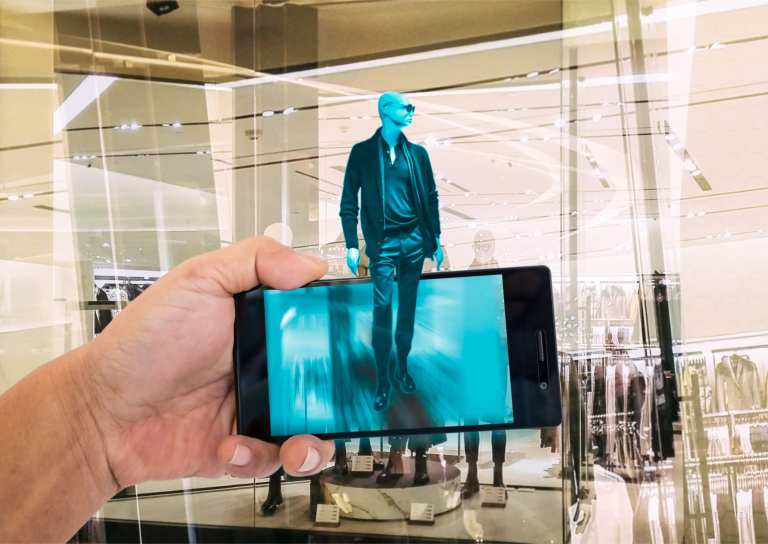
Future tech is no longer the province of high-end retailers. Innovations in 3D and augmented reality (AR) eCommerce are leveling the playing field and bringing conversion-centered visual technology to any online retailer.
“There have been amazing shifts in the ecosystem and demand is rising for 3D and AR tools that will help connect consumers with the right products and eliminate uncertainty in the buying journey,” said Ashley Crowder, CEO and co-founder of VNTANA, whose company introduced new visual eCommerce software on Feb. 19. “Virtual and augmented reality allows consumers to interact with a product, including manipulating it, visualizing it and trying it on. Our new platform is designed to help brands and creators realize that goal, and bring their products to life in minutes rather than weeks.”
This is not 3D printing, although 3D printing will enable instant product design and get closer to customized, real-time commerce. Future visual tech is coming to eCommerce in the form of 3D imaging, AR applications and virtual reality (VR) technology. VR will need a separate device to view and will need a dramatically increased penetration rate to be a real factor. But the other two technologies are up and running and will have a tangible effect on eCommerce metrics.
First, 3D. It’s generally agreed that Warby Parker’s usage of online frame fitting is one of the first scalable usages for 3D visual technology. The main expansion of 3D is being seen in its dual usage for consumers and retailers. 3D photo tech available from several smaller suppliers as well as Apple and Google gives consumers the opportunity to shoot a product before buying. The hosting technology gives the retailer an opportunity to get close to a showroom experience. Example: Trendy LA bike shop Pure Cycles encourages its customers to take 3D photos of a planned purchase, and even to take photos of individual parts. It then provides the option of buying a bike either way: complete or assembled. On the flip side, 3D tech allows a buyer to go to the Pure Cycles site and see all angles of the bike. Similar models are followed by Frye, adidas and Nike.
VNTANA and other software suppliers will eventually go beyond 3D and toward holograms. For now the proprietary 3D viewer and CMS enables brands to get onto customers’ screens before manufacturing and allows them to virtually try-on products at home. Virtual try-ons have been proven to increase conversions by more than 50 percent. Ninety-five percent of respondents to a recent survey preferred an interactive 3D representation to video playback. VNTANA claims that reducing the manual labor required 3D assets are dropped up to 95 percent.
Augmented reality, especially when combined with artificial intelligence, can create virtual spaces, such as aisles or predictive visualization of how a piece of furniture will look in a room. For example, Sephora cosmetics and perfume store has developed a tool for customers to put on virtual makeup. Shopify now provides its customers with the ability to use AR to help small businesses create 3D models of their products. According to Shopify, the introduction of a virtual hat fitting feature has allowed its client Tenth Street Hats to increase conversions by 33 percent and engagement by 74 percent.
“By blending the physical and digital worlds and enabling users to actively shape their experiences, AR offers unique ways for marketers to interact with consumers,” says a recent report from Boston Consulting Group. “These can range from brand overlays, to navigation and wayfinding, to virtual showrooming. Our survey of over 50 of the top 200 advertisers in the US shows that marketers recognize the opportunities in AR. More than four out of five respondents said that AR marketing is a differentiated way to engage with customers.”
At this point, future tech can have two main effects for eCommerce. First, it can create better initial decisions. AR allows consumers to try on makeup, clothing and accessories. These kinds of product tests could lessen expensive returns for retailers. More than 25 percent of products purchased online are sent back; retailers like Lowe’s, Target, and Amazon are using AR to address this.
Second, time on site: According to Google, the average eCommerce site visit last 1:50 seconds. If that shop time can be increased, by allowing consumers to see and interact with the product, site visits can be longer. Research conducted by Zappar and Mindshare found that AR delivers a 45 percent higher level of attention than TV. It found that 7-Eleven, in a tie-in with the movie “Deadpool 2,” allowed mobile app users to unlock AR experiences by scanning codes in-store. According to Zappar, the campaign generated over 3.2m interactions.
Retailers are making the technology available. What awaits that preparation is a prepared consumer. Smartphones and wearables can make VR and AR shopping a consistent reality.